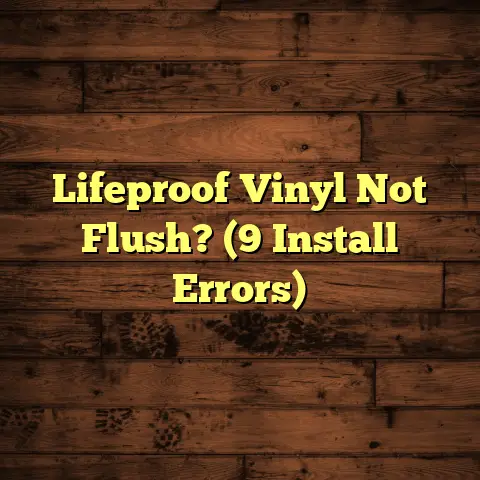Rough Up Ceramic Tile? (1 Quick Etch Trick!)
Remember the first time you stepped onto a beautifully tiled floor?
The coolness of ceramic tiles beneath your feet, giving you a sense of luxury and charm?
I remember helping my dad lay down ceramic tile in our kitchen when I was a kid. We were so proud!
But what happens when that once-glossy tile becomes slick, making it a safety hazard and less appealing?
If you’ve ever found yourself pondering how to revitalize those ceramic tiles without a complete overhaul, you’re in for a treat!
I’ve been a flooring contractor for over 20 years, and I’ve seen it all.
Slippery tile is a common problem, and I’m going to share a trick I’ve used for years to address it.
Section 1: Understanding
Ceramic Tiles
So, what are ceramic tiles exactly?
They’re basically hardened clay, fired at high temperatures.
Think of them as cousins to bricks and pottery, but designed specifically for flooring, walls, and countertops.
You see them everywhere: * Homes * Commercial spaces * Even swimming pools
A Little History
Ceramic tiles have been around for thousands of years!
The earliest examples date back to ancient Egypt and Mesopotamia.
Over time, the techniques and designs have evolved significantly.
From simple, hand-painted patterns to complex, machine-made mosaics, ceramic tiles have always been a popular choice for adding beauty and functionality to spaces.
The Magic of Ceramic:
Durability, Water Resistance,
and Appeal
Why are ceramic tiles so popular?
Well, they’re incredibly durable.
A properly installed ceramic tile floor can last for decades.
They are also naturally water-resistant, making them ideal for bathrooms, kitchens, and other areas prone to moisture.
And let’s not forget the aesthetics!
Ceramic tiles come in a vast array of colors, sizes, shapes, and patterns, allowing for endless design possibilities.
Finish Matters
The finish of a ceramic tile plays a big role in its performance and appearance.
Here’s a quick rundown:
-
Glossy: Reflective and easy to clean, but can be slippery when wet.
-
Matte: Less reflective, provides better traction, and hides dirt well.
-
Textured: Offers the best slip resistance, often used in showers and outdoor areas.
-
Satin: A balance between glossy and matte, offering a smooth, elegant look with decent traction.
The finish impacts how you’ll use the tile and, importantly, how slippery it might be.
Section 2: The Problem with
Smooth Ceramic Tiles
Okay, so we love the look of smooth, glossy ceramic tiles.
But what happens when they become a liability?
The Slip-and-Slide Effect
The main problem with smooth ceramic tiles is, well, they’re slippery!
Especially when wet.
Water reduces friction, and that glossy surface offers very little grip.
This can lead to slips, falls, and potential injuries.
Where the Danger Lurks
Here are some common scenarios where smooth ceramic tiles can become hazardous:
-
Bathrooms: Water from showers and baths makes the floor extremely slippery.
-
Kitchens: Spills of water, oil, or other liquids can create a dangerous situation.
-
Entryways: Rain or snow tracked in from outside can make the tiles slick.
-
Commercial Spaces: High-traffic areas with frequent cleaning can become slippery throughout the day.
The Numbers Don’t Lie
According to the CDC (Centers for Disease Control and Prevention), falls are a leading cause of injury and death in the United States. (Source: cdc.gov)
While not all falls are due to slippery tiles, it’s a significant contributing factor.
I’ve personally seen the aftermath of slip-and-fall accidents on tile floors, and it’s not pretty.
A simple slip can lead to broken bones, head injuries, and even long-term disability.
That’s why addressing slippery tile is so important.
Section 3: Traditional Methods
for Roughening Tiles
So, you’ve got slippery tiles. What can you do about it?
Before we get to my “Quick Etch Trick,” let’s look at some traditional methods.
Sanding: Abrasive Action
Sanding involves using sandpaper or a grinding tool to remove the glossy surface of the tile, creating a rougher texture.
Pros:
- Can be effective in increasing traction.
- Relatively inexpensive (depending on the tools you already own).
Cons:
- Time-consuming and labor-intensive.
- Creates a lot of dust.
- Can damage the tile if done improperly.
- May require resealing the tile.
Anti-Slip Coatings: The Layer
of Protection
Anti-slip coatings are liquid products that you apply to the tile surface.
They create a textured layer that increases friction.
Pros:
- Relatively easy to apply.
- Can be effective in improving slip resistance.
- Available in various finishes.
Cons:
- May require reapplication over time.
- Some coatings can change the appearance of the tile.
- Can be expensive, especially for large areas.
- Some coatings may yellow or peel over time.
Mats and Rugs: Simple Solutions
Placing mats or rugs in high-risk areas is a simple and effective way to improve traction.
Pros:
- Easy to implement.
- Relatively inexpensive.
- Can add color and style to the room.
Cons:
- Only covers a limited area.
- Can be a tripping hazard if not properly secured.
- Requires regular cleaning.
- May not be aesthetically pleasing in all situations.
Real-World Experiences
I’ve had clients who’ve tried all of these methods.
One client, Sarah, tried sanding her bathroom floor.
She said it took her an entire weekend, and the dust was a nightmare!
Plus, she wasn’t happy with the uneven finish.
Another client, Tom, used an anti-slip coating in his kitchen.
He said it worked well initially, but it started to peel after a few months, and he had to reapply it.
These traditional methods have their place, but they often come with drawbacks.
That’s why I started looking for a better solution.
Section 4: The Quick Etch Trick
Alright, here’s where the magic happens.
The “Quick Etch Trick” is a method I’ve developed over the years to safely and effectively roughen ceramic tiles using a mild etching solution.
What is Etching?
Etching involves using a chemical solution to subtly dissolve the surface of the tile.
This creates microscopic imperfections that increase traction without drastically altering the tile’s appearance.
Think of it like giving the tile a gentle “bite.”
Materials You’ll Need
Here’s what you’ll need to perform the Quick Etch Trick:
-
Muriatic Acid (Hydrochloric Acid): This is the etching agent. You can find it at most hardware stores. Important: Use extreme caution when handling muriatic acid. It is corrosive and can cause burns.
-
Water: For diluting the muriatic acid.
-
Two Plastic Buckets: One for the etching solution, one for rinsing.
-
Rubber Gloves: Essential for protecting your hands.
-
Safety Glasses: To protect your eyes from splashes.
-
Respirator: To avoid inhaling fumes.
-
Acid Brush: For applying the etching solution.
-
Clean Rags or Sponges: For wiping and rinsing.
-
Neutralizing Solution (Baking Soda and Water): To neutralize the acid after etching.
-
pH Testing Strips (optional): To ensure complete neutralization.
Step-by-Step Guide
Follow these steps carefully to etch your ceramic tiles safely and effectively:
Step 1: Preparation
- Safety First: Put on your rubber gloves, safety glasses, and respirator.
- Ventilation: Ensure the area is well-ventilated. Open windows and doors, or use a fan.
- Clear the Area: Remove any furniture or objects from the area you’ll be etching.
- Clean the Tiles: Thoroughly clean the tiles to remove any dirt, grease, or grime.
Step 2: Mixing the Etching Solution
- Dilution is Key: In one of the plastic buckets, carefully mix the muriatic acid with water. Always add acid to water, never water to acid. A good starting ratio is 1 part muriatic acid to 10 parts water.
- Stir Gently: Use a plastic or wooden stirrer to gently mix the solution. Avoid using metal stirrers.
Step 3: Testing the Solution
- The Spot Test: Before applying the solution to the entire area, test it on a small, inconspicuous spot.
- Apply and Observe: Use the acid brush to apply a small amount of the etching solution to the test area. Let it sit for 1-2 minutes.
- Rinse and Evaluate: Rinse the area thoroughly with water and dry it with a clean rag. Check the texture. If it’s not rough enough, you can increase the concentration of the acid slightly for the next test.
Step 4: Applying the Etching Solution
- Apply Evenly: Using the acid brush, apply the etching solution evenly to the tiles. Work in small sections (e.g., 2×2 feet) to prevent the solution from drying out.
- Timing is Crucial: Let the solution sit on the tiles for 1-3 minutes, depending on the desired level of etching and the type of tile. Keep a close eye on the tiles and don’t let the solution sit for too long.
Step 5: Rinsing Thoroughly
- Rinse, Rinse, Rinse: Use the second plastic bucket filled with clean water to thoroughly rinse the etched area. Use clean rags or sponges to remove all traces of the etching solution.
- Multiple Rinses: Rinse the area multiple times to ensure complete removal of the acid.
Step 6: Neutralizing the Acid
- Baking Soda Solution: Mix baking soda with water to create a neutralizing solution.
- Apply Liberally: Apply the baking soda solution to the etched area and let it sit for 5-10 minutes. This will neutralize any remaining acid.
- Final Rinse: Rinse the area thoroughly with clean water one last time.
Step 7: Drying and Inspection
- Dry the Tiles: Use clean rags or towels to dry the tiles completely.
- Inspect the Texture: Check the texture of the tiles. They should feel slightly rougher than before.
- Repeat if Necessary: If the tiles are not rough enough, you can repeat the etching process, but be careful not to over-etch them.
Step 8: Final Cleaning
- Clean the Entire Area: Once you’re satisfied with the texture, clean the entire area with a mild detergent and water.
- Admire Your Work: Enjoy your newly roughened, safer ceramic tiles!
Section 5: Benefits of Using
the Quick Etch Trick
Why choose the Quick Etch Trick over traditional methods?
Let me break it down:
Cost-Effectiveness
Compared to anti-slip coatings or professional sanding, the Quick Etch Trick is very affordable.
A gallon of muriatic acid is relatively inexpensive, and you probably already have most of the other materials on hand.
Ease of Use
While it requires caution, the Quick Etch Trick is relatively easy to perform.
With proper preparation and attention to detail, even a DIY novice can achieve good results.
Time-Saving
Compared to sanding, which can take hours or even days, the Quick Etch Trick can be completed in a few hours.
This is a huge time-saver for busy homeowners.
Maintaining the Look
The Quick Etch Trick doesn’t drastically alter the appearance of the tile.
It simply creates a subtle texture that improves traction without sacrificing the tile’s aesthetic appeal.
Real Success Stories
I’ve used the Quick Etch Trick for countless clients over the years.
One client, Maria, had a very slippery tile floor in her entryway.
She was worried about her elderly mother falling when she came to visit.
After using the Quick Etch Trick, Maria said she felt much more confident about her mother’s safety.
Another client, David, had a slippery tile floor in his commercial kitchen.
He was concerned about his employees getting injured.
After etching the tiles, David said his employees felt much more secure, and he noticed a significant reduction in slip-and-fall incidents.
These are just a few examples of how the Quick Etch Trick can make a real difference in people’s lives.
Section 6: Maintenance and
Care After Etching
Okay, you’ve etched your tiles. Now what?
Here’s how to maintain them to ensure long-lasting slip resistance:
Regular Cleaning
Clean your etched tiles regularly with a mild detergent and water.
Avoid using harsh chemicals or abrasive cleaners, as these can damage the etched surface.
Gentle Scrubbing
Use a soft-bristled brush or sponge to gently scrub the tiles.
This will help remove any dirt or grime that may accumulate in the etched texture.
Rinse Thoroughly
After cleaning, rinse the tiles thoroughly with clean water to remove any soap residue.
Drying is Key
Dry the tiles with a clean towel or mop to prevent water spots.
Periodic Inspection
Inspect your etched tiles periodically to check for any signs of wear or damage.
If you notice any areas that are becoming slippery again, you can re-etch them as needed.
Sealing (Optional)
While not always necessary, you can apply a sealant to your etched tiles to help protect them from stains and dirt.
Be sure to choose a sealant that is specifically designed for ceramic tiles.
By following these simple maintenance tips, you can keep your etched tiles looking great and providing excellent slip resistance for years to come.
Section 7: Other Creative
Solutions for Ceramic Tile Safety
While the Quick Etch Trick is my go-to solution for slippery tiles, there are other options worth considering:
Textured Coatings
Textured coatings are liquid products that you apply to the tile surface to create a slip-resistant finish.
These coatings come in various textures and colors, allowing you to customize the look of your tiles.
Slip-Resistant Mats
Slip-resistant mats are a simple and effective way to improve traction in high-risk areas.
These mats are available in various sizes, shapes, and materials, and they can be easily moved and cleaned.
Textured Tiles
If you’re planning a new tile installation, consider using textured tiles.
These tiles have a naturally rough surface that provides excellent slip resistance.
Tile Sealers
While sealers won’t roughen the tile, some are designed to improve slip resistance.
Look for sealers specifically marketed for this purpose.
These alternative solutions can complement the Quick Etch Trick and provide an extra layer of safety and peace of mind.
Conclusion
Remember that cool, smooth tile floor from the beginning?
It doesn’t have to be a hazard!
By taking action and using the Quick Etch Trick, you can transform your ceramic tiles into safer, more welcoming spaces.
It’s a simple, effective, and affordable solution that can make a real difference in your home or business.
So, what are you waiting for?
Grab your safety glasses, put on your gloves, and get ready to etch your way to a safer, more beautiful floor!
You’ve got this!





